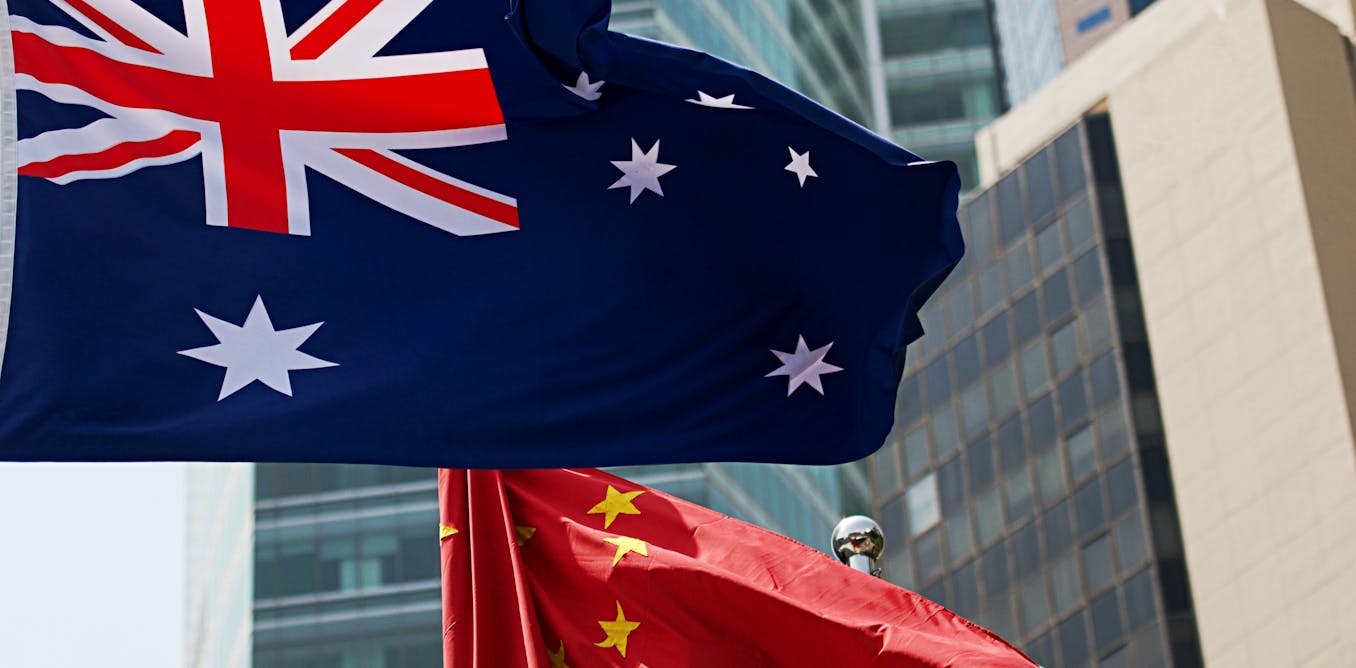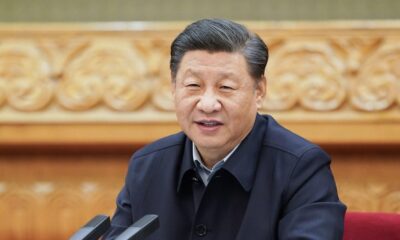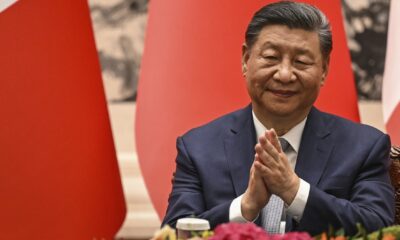China
Understanding risks for Australia of China’s slowing economy is Chalmers’ top priority at upcoming Beijing talks

Treasurer Jim Chalmers will visit Beijing for the Australia-China Strategic Economic Dialogue, addressing economic ties, trade issues, and concerns regarding China’s investments in Australia amidst complex bilateral relations.
When Treasurer Jim Chalmers travels to Beijing later this month, he and his counterpart at China’s peak economic agency, the National Development and Reform Commission, won’t be short on important topics to discuss.
Chalmers will be attending the Australia-China Strategic Economic Dialogue, one part of a tripartite agreement secured by the Gillard government in 2013.
The purpose was to hold annual talks at the highest level. The agreement also includes a Leaders’ Dialogue and a Foreign and Strategic Dialogue involving the two countries’ foreign ministers.
Troubled times
The dialogue was last held in September 2017 as the state of official ties began turning south.
It was then formally suspended by Beijing in May 2021 after the Morrison government cancelled the Victorian state government’s Memorandum of Understanding to participate in China’s “belt and road initiative”.
Its resurrection has been slow in coming. The stabilisation in the bilateral relationship under the Albanese government has already seen reciprocal visits involving leaders and foreign ministers. But it was not until June the two sides signed a new memorandum to bring back the dialogue.
The fact Chalmers was able to confirm the trip last Sunday is another sign Canberra and Beijing remain committed to talking. This is despite there being numerous issues over which they are at odds.
Chalmers’ concerns
For the Treasurer, the priority will be getting a first-hand read on China’s struggling economy and the risks this presents to Australia’s own outlook.
When announcing the visit he alluded to one scenario his department was tracking that could see Commonwealth budget revenue take a $4.5 billion hit due to falling prices for key commodity exports, including iron ore and lithium.
Slowing Chinese growth and falling commodity prices are clearly not positives for Australian income, but Chalmers is unlikely to return in a state of panic.
The latest trade figures show China continuing to import Australian iron ore and lithium at record or near record volumes.
Despite slowing growth China is still importing large volumes of Australia’s iron ore.
Dean Lewins/AAP
This points to increasing supply and a lack of demand from other countries being at least as relevant in explaining recent price falls. And both are coming off extraordinary price spikes to now be approaching levels more in line with historical averages.
The impact of Chinese growth on its demand for Australian goods and services has also never been a simple, one-to-one relationship. That remains true today.
A complex relationship
Australian wine exports, for example, are booming after Beijing removed tariffs earlier this year.
China’s customs agencies put the value of imported Australian wine over the past three months at US$252 million, or around A$400 million. This topped the $A357 million sold over the past year to the US, Australia’s second largest customer.
Students from China are also commencing at Australian universities in record numbers, albeit this is likely to fall next year due to restrictions imposed by Canberra, not Beijing.
That China remains a stand-out market is reflected in the large numbers of businesses and politicians attending the Australia-China Business Council’s Canberra Networking Day on Thursday. Trade Minister Don Farrell, Foreign Minister Penny Wong, Shadow Trade Minister Kevin Hogan and Shadow Foreign Minister Simon Birmingham are all slated to give speeches.
Chalmers will also be keen to raise the lingering import ban Beijing imposed in 2020 affecting Australian lobsters. Trade Minister Don Farrell said in June he was “very confident that in the near future” the ban would be lifted. Chalmers’ visit might provide the occasion to announce a final resolution.
China’s concerns
For China, top of the list of concerns will be Australia’s treatment of Chinese investors, particularly in sectors like critical minerals. In the past they have been welcomed but since 2020 there’s been an apparent de-facto ban on further involvement.
A recent survey of Chinese businesses in Australia pointed to generally positive sentiment. Almost 80% said they were optimistic about the outlook of the local business environment. Still, while 72.5% did not consider they had experienced discriminatory treatment, 42.4% felt the enforcement of Australia’s laws and regulations lacked transparency.
It’s not hard to see why. When Chalmers was asked in an interview last Sunday whether or not he wanted “China’s investment in critical minerals processing in Australia”, he did not reply with a “no”. Nor did he provide even a qualified “yes”.
China will likely also be seeking reassurance Canberra will not join Washington and some other capitals usually regarded as geopolitically “like-minded” in putting up tariff barriers on Chinese imports.
This reassurance shouldn’t be difficult for Chalmers to provide. Unlike the US, Australia’s economic relationship with China remains overwhelmingly complementary. Last year, Australia’s exports to China exceeded imports by $110.7 billion.
And low-cost, high-quality imports from China, such as electric vehicles, would be welcomed by the government amid a cost-of-living crisis and the net zero transition.
Late last month, Chris Bowen, Australia’s Minister for Climate and Energy, hosted his Chinese counterpart for the 8th Australia-China Ministerial Dialogue on Climate Change in Sydney.
A bipartisan approach
Trade with China also enjoys bipartisan support. In March, Minister Farrell touted the potential for two-way trade to increase from $300 billion to $400 billion.
Not to be outdone, opposition leader Peter Dutton said in June he’d “love to see the trading relationship [with China] increase two-fold”.
Chalmers was on the money this week in stating Australia’s relationship with China is now “full of complexity and full of opportunity”. His upcoming trip can only help in managing the former and realising the latter.
This article is republished from The Conversation under a Creative Commons license. Read the original article.
Business
Wegovy: The Popular Weight-Loss Drug Now Available in China

Novo Nordisk launched Wegovy in China after approval, competing with Eli Lilly’s upcoming weight-loss drug. The treatment, costing 1,400 yuan, targets obesity but has potential side effects and isn’t covered by healthcare.
Wegovy Launch in China
Novo Nordisk recently launched its weight-loss drug, Wegovy, in China after obtaining approval from local health authorities in June. The introduction of Wegovy is expected to increase competition with Eli Lilly, which has also received approval for its weight-loss treatment, although it has not yet been released in China’s significant pharmaceutical market.
Cost and Accessibility
In China, a set of four Wegovy injections will be priced at 1,400 yuan (approximately $194), significantly lower than the drug’s U.S. price. However, patients will need to pay the full amount out of pocket since Wegovy is not yet covered by the national healthcare insurance plan.
Benefits and Side Effects
Research indicates that Wegovy can help users lose over 10% of their body weight. The drug contains semaglutide, which assists with appetite control and satiety. While Wegovy has been gaining traction globally, it may cause side effects like nausea. Concerns have emerged about its misuse among individuals who are not obese, prompting medical professionals to remain vigilant.
Source : Popular weight-loss drug Wegovy goes on sale in China
China
China Implements New Measures to Increase Foreign Investment in A-Share Market

China’s 2024 updates to strategic investment rules simplify A-share market access for foreign investors by lowering shareholding thresholds, reducing lock-up periods, and increasing investment options, reflecting a commitment to greater market openness and participation in economic reform.
The 2024 updates to China’s strategic investment rules simplify entry for foreign investors in the A-share market by lowering shareholding thresholds, reducing lock-up periods, and expanding investment options, signaling a commitment to increased market openness and flexibility through these new measures.
China’s capital markets are undergoing a significant transformation as part of the nation’s ongoing commitment to economic reform and openness. The recent update to the Administrative Measures for Strategic Investment in Listed Companies by Foreign Investors (hereinafter, the “new measures”) reflects this commitment, targeting an increase in foreign investor participation in China’s A-share market. For nearly two decades, China’s “strategic investment” pathway provided foreign investors with access to shares in A-share listed companies, but strict requirements—such as high minimum investment thresholds and prolonged lock-up periods—made it accessible only to select large investors.
The new measures, effective December 2, 2024, relax many of these restrictions to attract a broader and more diverse range of foreign investors. Key changes include lowering the minimum shareholding threshold from 10 percent to 5 percent, reducing the asset requirements from US$100 million to US$50 million in assets, and shortening the lock-up period from three years to one. Additionally, foreign investors can now use equity from unlisted overseas companies as consideration, while new investment routes, like tender offers, enhance flexibility.
In 2005, China introduced the Strategic Investment Regime as part of its broader efforts to open up its financial markets to foreign capital while retaining a level of control over sensitive industries. This framework allowed qualified foreign investors to acquire strategic stakes in Chinese A-share listed companies, aiming to promote foreign participation in the domestic market.
However, the stringent requirements—such as high minimum investment thresholds and extended lock-up periods—restricted this pathway to a limited pool of large, multinational investors. The regime reflected China’s cautious approach at the time, seeking to balance openness with economic stability and control over critical sectors.
A decade later, in 2015, China implemented its first significant revisions to the Strategic Investment Regime. These amendments sought to make the investment process more accessible by easing certain restrictions, aiming to encourage foreign capital inflow as China continued its gradual integration into global markets.
While some requirements were relaxed, the fundamental limitations—such as high entry thresholds and complex approval processes—remained in place, meaning that access to China’s A-share market was still primarily confined to major institutional investors with substantial capital.
| This article was first published by China Briefing , which is produced by Dezan Shira & Associates. The firm assists foreign investors throughout Asia from offices across the world, including in in China, Hong Kong, Vietnam, Singapore, and India . Readers may write to info@dezshira.com for more support. |
Read the rest of the original article.
China
Less is More: Rethinking Indonesia’s Tariffs on China
Rising concerns over China’s industrial overcapacity have led countries to impose higher tariffs, including Indonesia’s planned 200% tariffs on Chinese goods, risking Indonesia’s competitiveness and economic security.
Tariffs Escalate Amid Concerns of Overcapacity
Concerns regarding China’s industrial overcapacity have prompted countries to increase tariffs on Chinese goods. Indonesia, following the U.S. example, plans to impose tariffs as high as 200 percent on various Chinese imports, including textiles and ceramics. This response aims to safeguard local jobs from the influx of inexpensive Chinese products.
Economic Impact of Tariffs
These tariffs are designed as safeguards and anti-dumping measures against potential job losses in Indonesia. However, the ongoing investigations have not definitively shown that China’s practices are the root cause of these issues. The political appeal of broad tariffs might lead to unintended consequences, such as reducing the overall competitiveness of Indonesian exports and risking retaliatory measures from affected countries.
Dependency on Chinese Goods
Indonesia heavily relies on Chinese manufacturing inputs, which constituted over 26 percent of its intermediary goods imports in 2021. With competitive pricing, these inputs have enhanced Indonesia’s export capabilities, particularly to markets like the U.S., where the trade surplus increased from $8.58 billion in 2019 to $11.96 billion in 2023. Reducing trade openness may ultimately undermine the Indonesian economy’s resilience against geopolitical challenges.











